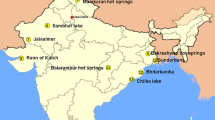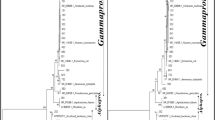Abstract
In order to obtain the diversity and temporal–spatial distribution of Bacillus community during the swine manure composting, we utilized traditional culture methods and the modern molecular biology techniques of polymerase chain reaction–restriction fragment length polymorphism (PCR-RFLP) and –denaturing gradient gel electrophoresis (PCR-DGGE). Bacillus species were firstly isolated from the composting. Based on temperature changes, the temporal–spatial characteristics of total culturable Bacillus were remarkable that the number of the culturable Bacillus detected at the high-temperature stage was the highest in each layer of the pile and that detected in the middle layer was the lowest at each stage of composting respectively. The diversity of cultivated Bacillus species isolated from different composting stages was low. A total of 540 isolates were classified by the RFLP method and partial 16S rDNA sequences. They affiliated to eight species including Bacillus subtilis, Bacillus cereus, Bacillus thuringiensis, Bacillus anthracis, Bacillus megaterium, Bacillus licheniformis, Bacillus pumilus, and Bacillus circulans. The predominant species was B. subtilis, and the diversity of culturable Bacillus isolated in the middle-level samples at temperature rising and cooling stages was the highest. The DGGE profile and clone library analysis revealed that the temporal–spatial distribution of Bacillus community was not obvious, species belonging to the Bacillus were dominant (67%) with unculturable bacteria and B. cereus was the second major culturable Bacillus species. This study indicated that a combination of culture and culture-independent approaches could be very useful for monitoring the diversity and temporal–spatial distribution of Bacillus community during the composting process.



Similar content being viewed by others
References
Amann RI, Ludwig W, Schleifer KH (1995) Phylogenetic identification and in situ detection of individual microbial cells without cultivation. Microbiol Mol Biol Rev 59:143–169
Bizet C, Barreau C, Harmant C, Nowakowski M, Pietfroid A (1997) Identification of Rhodococcus, Gordona and Dietzia species using carbon source utilization tests. Res Microbiol 148:799–809
Boon N, Windt W, Verstraete W, Top EM (2002) Evaluation of nested PCR-DGGE (denaturing gradient gel electrophoresis) with group-specific 16S rRNA primers for the analysis of bacterial communities from different wastewater treatment plants. FEMS Microbiol Ecol 39:101–112
Buchanan RE, Gibbons NE (1984) Bergey's manual of determinative bacteriology, 8th edn. The Williams and Wilkins Co., Baltimore
Crawford J (1983) Composting of agricultural wastes—a review. Process Biochem 18:14–18
Dojka MA, Hugenholtz P, Haack SK, Pace NR (1998) Microbial diversity in a hydrocarbon-and chlorinated-solvent-contaminated aquifer undergoing intrinsic bioremediation. Appl Environ Microbiol 64:3869–3877
Felske A, Wolterink A, Lis R, Vos WM, Akkermans ADL (1999) Searching for predominant soil bacteria: 16S rDNA cloning versus strain cultivation. FEMS Microbiol Ecol 30:137–145
Fritze D (2004) Taxonomy of the genus Bacillus and related genera: the aerobic endospore-forming bacteria. Phytopathology 94:1245–1248
Ghosh S, Kapadnis B, Singh N (2000) Composting of cellulosic hospital solid waste: a potentially novel approach. Int Biodeterior Biodegradation 45:89–92
Goyal S, Dhull S, Kapoor K (2005) Chemical and biological changes during composting of different organic wastes and assessment of compost maturity. Bioresour Technol 96:1584–1591
Gray K, Sherman K, Biddlestone A (1971) A review of composting. Part 1. Process Biochem 6:32–36
Guo Y, Zhu N, Zhu S, Deng C (2007) Molecular phylogenetic diversity of bacteria and its spatial distribution in composts. J Appl Microbiol 103:1344–1354
Ishii K, Fukui M, Takii S (2000) Microbial succession during a composting process as evaluated by denaturing gradient gel electrophoresis analysis. J Appl Microbiol 89:768–777
Kisand V, Wikner J (2003) Combining culture-dependent and-independent methodologies for estimation of richness of estuarine bacterioplankton consuming riverine dissolved organic matter. Appl Environ Microbiol 69:3607–3616
Lane D (1991) 16S/23S rRNA sequencing. In: Stackebrandt E, Goodfellow M (eds) Nucleic acid techniques in bacterial systematics. Wiley, Chichester, pp 115–175
Mavingui P, Laguerre G, Berge O, Heulin T (1992) Genetic and phenotypic diversity of Bacillus polymyxa in soil and in the wheat rhizosphere. Appl Environ Microbiol 58:1894–1903
Miller FC (1989) Matric water potential as an ecological determinant in compost, a substrate dense system. Microb Ecol 18:59–71
Millner P (1982) Thermophilic and thermotolerance Actinomycetes in sewage-sludge compost. Dev Indust Microbiol 23:61–80
Nengwu Z, Changyan D, Yuanzhu X, Wanyong T (2003) Design and operational effect of time/temperature-based aeration control system for aerobic composting. Trans CSAE 19:282–286
Peters S, Koschinsky S, Schwieger F, Tebbe CC (2000) Succession of microbial communities during hot composting as detected by PCR-single-strand-conformation polymorphism-based genetic profiles of small-subunit rRNA genes. Appl Environ Microbiol 66:930–936
Reva ON, Dixelius C, Meijer J, Priest FG (2004) Taxonomic characterization and plant colonizing abilities of some bacteria related to Bacillus amyloliquefaciens and Bacillus subtilis. FEMS Microbiol Ecol 48:249–259
Ryckeboer J, Mergaert J, Coosemans J, Deprins K, Swings J (2003) Microbiological aspects of biowaste during composting in a monitored compost bin. J Appl Microbiol 94:127–137
Saitou N, Nei M (1987) The neighbor-joining method: a new method for reconstructing phylogenetic trees. Mol Biol Evol 4:406–425
Sambrook J, Fritsch EF, Maniatis T (1989) Molecular cloning: a laboratory manual, 2nd edn. Cold Spring Harbor Laboratory Press, New York
Sanguinetti C, Dias NE, Simpson A (1994) Rapid silver staining and recovery of PCR products separated on polyacrylamide gels. Biotechniques 17:914–921
Sessitsch A, Kan FY, Pfeifer U (2003) Diversity and community structure of culturable Bacillus spp. populations in the rhizospheres of transgenic potatoes expressing the lytic peptide cecropin B. Appl Soil Ecol 22:149–158
Takaku H, Kodaira S, Kimoto A, Nashimoto M, Takagi M (2006) Microbial communities in the garbage composting with rice hull as an amendment revealed by culture-dependent and-independent approaches. J Biosci Bioeng 101:42–50
Torsvik V, Goksoyr J, Daae FL (1990) High diversity in DNA of soil bacteria. Appl Environ Microbiol 56:782–787
Wagner M, Amann R, Lemmer H, Schleifer KH (1993) Probing activated sludge with oligonucleotides specific for proteobacteria: inadequacy of culture-dependent methods for describing microbial community structure. Appl Environ Microbiol 59:1520–1525
Ward D, Bateson M, Weller R, Ruff-Roberts A (1992) Ribosomal RNA analysis of microorganisms as they occur in nature. Adv Microb Ecol 12:219–286
Zhang YC, Ronimus RS, Turner N, Zhang Y, Morgan HW (2002) Enumeration of thermophilic Bacillus species in composts and identification with a random amplification polymorphic DNA (RAPD) protocol. Syst Appl Microbiol 25:618–626
Zhou J, Bruns MA, Tiedje JM (1996) DNA recovery from soils of diverse composition. Appl Environ Microbiol 62:316–322
Zhu N, Deng C, Xiong Y, Qian H (2004) Performance characteristics of three aeration systems in the swine manure composting. Bioresour Technol 95:319–326
Acknowledgments
This study was supported financially by the National Natural Science Foundation of China (Project No: 30800797), Hubei Province National High Technology Development Project (Project No: 2009CDA091), and Hubei Key Laboratory of Animal Embryo and Molecular Breeding, Hubei Academy of Agriculture Sciences (Project No: 2011ZD201).
Author information
Authors and Affiliations
Corresponding author
Rights and permissions
About this article
Cite this article
Yi, J., Wu, HY., Wu, J. et al. Molecular phylogenetic diversity of Bacillus community and its temporal–spatial distribution during the swine manure of composting. Appl Microbiol Biotechnol 93, 411–421 (2012). https://doi.org/10.1007/s00253-011-3425-x
Received:
Revised:
Accepted:
Published:
Issue Date:
DOI: https://doi.org/10.1007/s00253-011-3425-x




